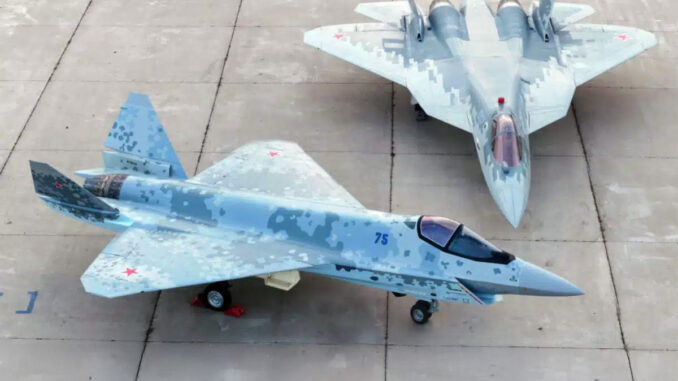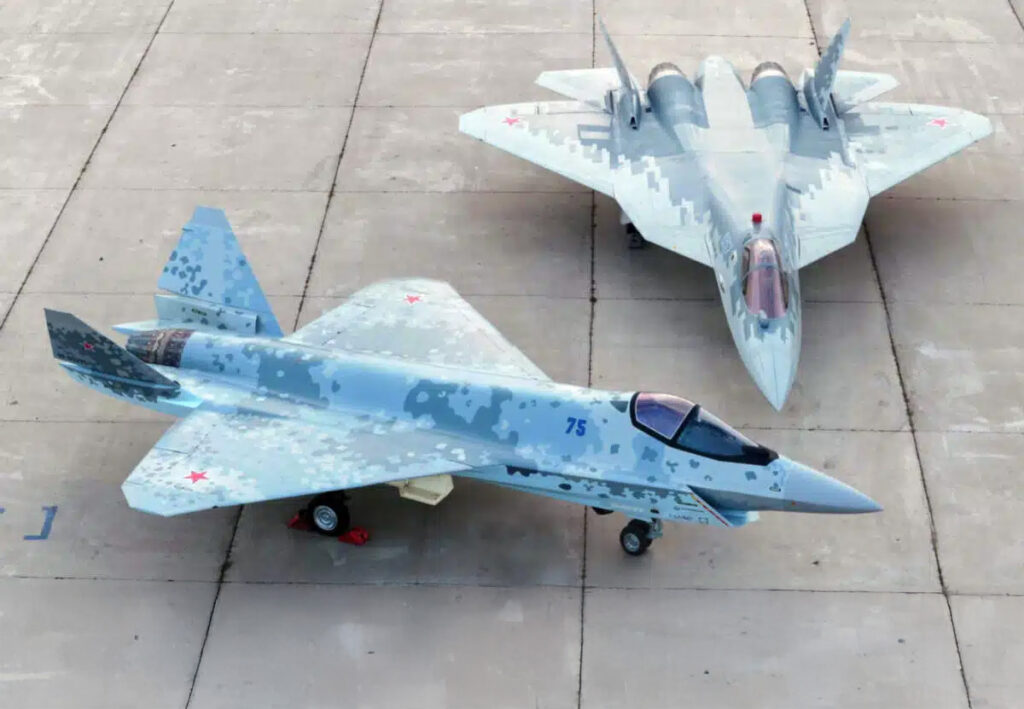
Technical analysis of the Sukhoi Su-75 Checkmate and the Russian industrial challenges that jeopardise its success against the American F-35.
The Sukhoi Su-75 Checkmate is a 5th generation stealth fighter project developed by Russia to compete with the American F-35 Lightning II. Despite an ambitious presentation in 2021, the aircraft is struggling to attract international customers. The economic sanctions imposed on Russia have reduced its industrial capacity, calling into question the viability of the project. This article analyses the technical and strategic reasons why the Su-75 may never take off.
Technical analysis of the Sukhoi Su-75 Checkmate
The Sukhoi Su-75 Checkmate is designed as a 5th generation single-engine fighter, with an emphasis on stealth and operational economy. With an estimated top speed of Mach 1.8 and a range of 2,800km, it aims to be a more affordable alternative to the twin-engined Su-57 Felon. The Su-75 is supposed to be equipped with an AESA (Active Electronically Scanned Array) radar and capable of carrying up to 7 tonnes of weaponry.
However, the project has remained at the mock-up stage since its unveiling at the MAKS air show in 2021. No prototype version has been presented, which raises questions about the technological maturity of the programme. Experts also point to the lack of funding and technical resources needed to complete such a development, especially in Russia’s current economic climate.
Impact of international sanctions on the Russian aerospace industry
The international sanctions imposed on Russia since 2014, and reinforced after the invasion of Ukraine in 2022, have significantly affected its aerospace industry. Restrictions on exports of advanced technologies and financial limitations have led to delays in several military programmes, including the Su-75.
These sanctions have reduced Russia’s access to advanced electronic components essential for modern avionics systems. In addition, the lack of foreign investment and international partnerships is limiting Russia’s ability to innovate and mass-produce competitive combat aircraft. As a result, the Su-75 is likely to remain a paper project with no prospect of concrete realisation.

The commercial failure of the Su-57 Felon as a precedent
The Su-57 Felon, Russia’s first 5th generation stealth fighter, has itself encountered export difficulties. Despite impressive performance claims, the aircraft failed to convince foreign customers. India, the programme’s initial partner, pulled out in 2018, citing performance problems and high costs.
This commercial failure of the Su-57 serves as a worrying precedent for the Su-75. If Russia failed to export the more technologically advanced Su-57, it is unlikely that the Su-75 will find buyers without a solid operational reference in the Russian or foreign air forces. Potential customers are reluctant to invest in an aircraft without a proven track record of reliability and logistical support.
Potential customers and their reluctance
Countries such as Algeria, traditional customers of the Russian aerospace industry, have expressed reservations about acquiring the Su-75. Preferring proven aircraft, Algeria continues to invest in aircraft such as the Su-30MKA Flanker-C and is considering the Su-34 Fullback to replace its ageing Su-24 Fencer.
Other potentially interested countries, such as Iran and Venezuela, face financial and political constraints that limit their ability to acquire modern combat aircraft. In addition, Russia’s reputation for after-sales service and maintenance is a deterrent for many buyers, who fear difficulties in obtaining spare parts and insufficient technical support.
Strategic consequences for Russia
The potential failure of the Su-75 has strategic implications for Russia. Unable to compete effectively with Western aircraft such as the F-35, Russia risks losing significant market share in military aviation. It also weakens its geopolitical position, as arms exports are a key tool of its international influence.
What’s more, the lack of success of the Su-75 could discourage future investment in the development of new-generation combat aircraft. Russia could be forced to concentrate on modernising its existing fleet rather than pursuing ambitious but uncertain projects, thereby limiting its ability to maintain a technologically advanced air force.
Future prospects for the Russian aerospace industry
Faced with these challenges, the Russian aerospace industry needs to rethink its strategy. One option would be to strengthen international cooperation with countries not aligned with Western sanctions, although this presents its own challenges. Investing in domestic research and development to overcome technological obstacles is also crucial.
Russia could also turn to niche markets, offering specialised aircraft or customised solutions for specific customer needs. However, without a significant improvement in its reputation for reliability and logistical support, these efforts may not be enough to revitalise its military aerospace industry.
War Wings Daily is an independant magazine.